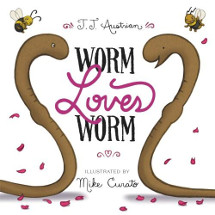Worm loves Worm by J.J. Austrian

Ill. by Mike Curato. Balzer & Bray, 2016. ISBN 9780062386335
Worm loves Worm. So they decide to get married. It shouldn't be a
problem but suddenly all their minibeast friends chip in. "You'll
need someone to marry you. That's how it's always been done." You'll
need a best man, bridesmaids, rings, a band... and so on and so
on, because "that's how it's always been done."
Worm and Worm agree to each suggestion hoping that after they
acquiesce they can get married but no... there is always
something else. So when they are told that they need to have a bride
and groom, worms being hermaphrodites, they have no trouble with
being either or both - but that isn't how it's always been done.
Will they ever just celebrate their love by getting married???
This is a charming book that, on the surface, is just a story about
two worms wanting to get married because they love each other, and
that, to a four-year-old is a natural thing to do. It is just a
celebration of love. For those in different circumstances or a
little bit older there is a sub-text of marriage equality and things
can change - things don't always have to be because they have always
been. It's enough to love each other without all the other
trappings; it's about inclusion and equality and showing affection
regardless of any traditional views and values that have been
imposed on a natural state of mind. That's what little ones
understand and accept - intolerance is something they learn.
Choosing worms as the main characters is a masterstroke because
there are no physical differences between worms - there is nothing
to say which is female and therefore the bride or male and therefore
the groom. So the central message of love being the key ingredient
and the rest of the elements of a wedding just being seasoning
remains the central theme. Perhaps some of our politicians and those
who influence them should read this and get to the core of what
really matters.
A great addition to a school library collection that allows children
to see their own family structure in a story, to show others that
there are all sorts of family structures, and to explain marriage
equality to those unfamiliar with the concept.
Barbara Braxton